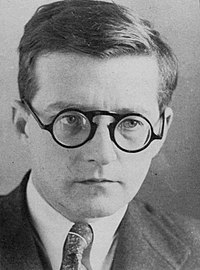
Sonata, in music, literally means a piece played as opposed to a cantata, a piece sung. The term evolved through the history of music, designating a variety of forms until the Classical era, when it took on increasing importance. Sonata is a vague term, with varying meanings depending on the context and time period. By the early 19th century, it came to represent a principle of composing large-scale works. It was applied to most instrumental genres and regarded—alongside the fugue—as one of two fundamental methods of organizing, interpreting and analyzing concert music. Though the musical style of sonatas has changed since the Classical era, most 20th- and 21st-century sonatas still maintain the same structure.

The term string quartet can refer to either a type of musical composition or a group of four people who play them. Many composers from the mid-18th century onwards wrote string quartets. The associated musical ensemble consists of two violinists, a violist, and a cellist.
Dmitri Shostakovich's String Quartet No. 8 in C minor, Op. 110, was written in three days.

Nikolai Yakovlevich Myaskovsky or Miaskovsky or Miaskowsky, was a Russian and Soviet composer. He is sometimes referred to as the "Father of the Soviet Symphony". Myaskovsky was awarded the Stalin Prize five times.
The viola sonata is a sonata for viola, sometimes with other instruments, usually piano. The earliest viola sonatas are difficult to date for a number of reasons:

The Cello Sonata No. 3 in A major, Op. 69, is the third of five cello sonatas by Ludwig van Beethoven. He composed it in 1807–08, during his productive middle period. It was first performed in 1809 by cellist Nikolaus Kraft and pianist Dorothea von Ertmann, a student of Beethoven. Published by Breitkopf & Härtel the same year, it was dedicated to Freiherr Ignaz von Gleichenstein, Beethoven's friend and an amateur cellist. The sonata was successful with audiences from the beginning.

B-flat major is a major scale based on B♭, with pitches B♭, C, D, E♭, F, G, and A. Its key signature has two flats. Its relative minor is G minor and its parallel minor is B-flat minor.
E-flat major is a major scale based on E♭, consisting of the pitches E♭, F, G, A♭, B♭, C, and D. Its key signature has three flats. Its relative minor is C minor, and its parallel minor is E♭ minor,.

The Piano Trio No. 2 in E minor, Op. 67, is a piece for violin, cello and piano by the Russian composer Dmitri Shostakovich, started in late 1943 and completed in August the following year. It was premiered on 14 November 1944. The piece was dedicated to his close friend Ivan Sollertinsky, whose death in February 1944 affected Shostakovich profoundly.
Dmitri Shostakovich's String Quartet No. 1 in C major, Op. 49, was composed in six weeks during the summer of 1938. It carries no dedication. Shostakovich said that in this quartet he had "visualized childhood scenes, somewhat naïve and bright moods associated with spring."

Piano Concerto No. 2 in F major, Op. 102, by Dmitri Shostakovich was composed in 1957 for the 19th birthday of his son Maxim, who premiered the piece during his graduation concert at the Moscow Conservatory. It contains many similar elements to Shostakovich's Concertino for Two Pianos: both works were written to be accessible for developing young pianists. It is an uncharacteristically cheerful piece, much more so than most of Shostakovich's works.
Dmitri Shostakovich composed his String Quartet No. 7 in F-sharp minor, Op. 108, in 1960. He dedicated it to the memory of his first wife Nina Vassilyevna Varzar, who died in December 1954. This piece was composed in the year that would have marked her 50th birthday. This quartet was premiered in Leningrad Glinka Concert Hall by the Beethoven Quartet on May 15, 1960.

Dmitri Shostakovich's String Quartet No. 10 in A-flat major, Op. 118, was composed from 9 to 20 July 1964. It was premiered by the Beethoven Quartet in Moscow and is dedicated to composer Mieczysław (Moisei) Weinberg, a close friend of Shostakovich. It has been described as cultivating the uncertain mood of his earlier Stalin-era quartets, as well as foreshadowing the austerity and emotional distance of his later works. The quartet typified the preference for chamber music over large scale works, such as symphonies, that characterised his late period. According to musicologist Richard Taruskin, this made him the first Russian composer to devote so much time to the string quartet medium.
DSCH is a musical motif used by the composer Dmitri Shostakovich to represent himself. It is a musical cryptogram in the manner of the BACH motif, consisting of the notes D, E-flat, C, B natural, or in German musical notation D, Es, C, H, thus standing for the composer's initials in German transliteration: D. Sch..
Boris Ivanovich Tishchenko was a Russian and Soviet composer and pianist.

The Piano Sonata No. 2 in B minor, Op. 61 by Dmitri Shostakovich, the last of his piano sonatas, was composed in early 1943. It was his first piano composition since the 24 Preludes, Op. 34 from 1933 and his second attempt at composing a piano sonata in the key of B-minor. John Jonas Gruen said that there was "nothing obscure or technically impenetrable" about this sonata, but that "something disquieting—something faintly obsessive—emerges from its deceptively simple structure."

Dmitri Shostakovich composed his Sonata for Violin and Piano in G major, Op. 134 in the autumn of 1968 in Moscow, completing it on October 23. It is set in three movements and lasts approximately 31 minutes. It is dedicated to the violinist David Oistrakh, who premiered the work on May 3, 1969 in the Large Hall of the Moscow Conservatory.
The Sonata for Viola and Piano, Op. 147, is the last composition by Dmitri Shostakovich. It was completed on July 5, 1975, weeks before his death. It is dedicated to Fyodor Druzhinin, violist of the Beethoven Quartet.
Scherzo in F-sharp minor is a piece for orchestra written by Dmitri Shostakovich (1906–1975). Shostakovich was a Russian composer and pianist during the Soviet era. It was most likely written in 1921 or 1922 while Shostakovich was studying at the Petrograd Conservatory under Maximilian Steinberg. The composition is one of the composer's earliest surviving works. Originally written as a single movement of a piano sonata, the Scherzo was later orchestrated with assistance from Steinberg and became an orchestral work in its own right.









